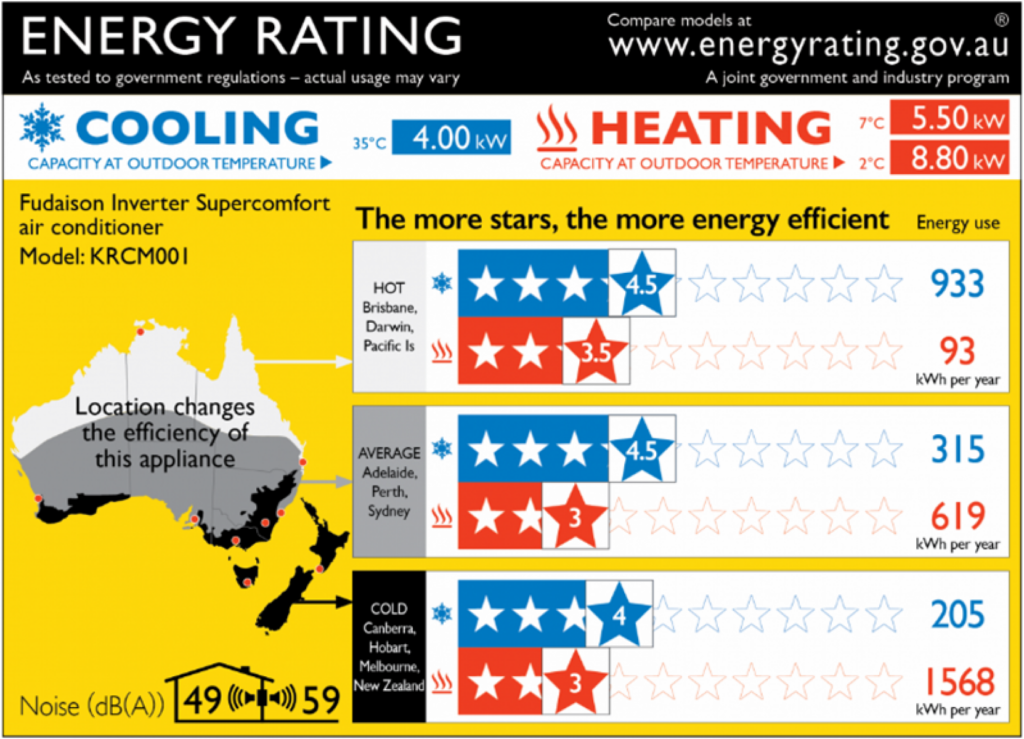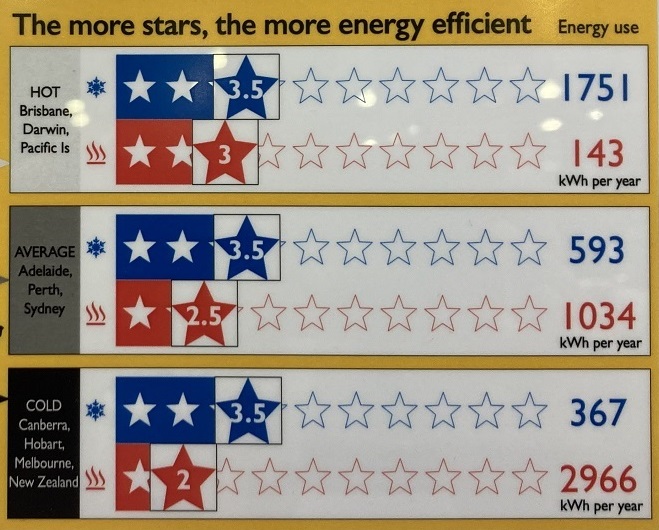A Beginner's Guide to Buying Air Conditioners
The Victorian Energy Upgrades (VEU) initiative provides incentives for homeowners to switch to reverse cycle air conditioners that offer both heating and cooling. Only those products that comply with VEU program standards are eligible for installation. We suggest consulting with our accredited installer regarding the appropriate sizing. If the system you plan to install is smaller than the size suggested in this fact sheet, you might not achieve the desired heating and cooling performance.
Before investing in a new system, consider the efficiency of your home. An efficient home will be easier and cheaper to heat and cool.
Are there draughts in your home?
-
Look for gaps around windows, doors and vents that allow hot and cool air to escape.
-
These gaps can increase your heating and cooling costs.
It is recommended to seal these gaps to help control the temperature of your home and lower your heating and cooling needs.
-
Do you have standard or high ceilings?
-
Are your roof, walls, and floors insulated?
Ask yourself the following questions:
-
What rooms do you heat or cool the most?
-
What are the hottest and coldest rooms in your home?
We recommend that your new system covers your primary living spaces such as
-
living room
-
family rooms
-
lounges and open plan living areas.
All these factors impact the amount of heating and cooling your house may need.
-
Which rooms need heating and cooling?
-
When considering a new reverse cycle air conditioner, discuss the rooms you want heated and cooled with your installer.
Additionally, consider which rooms are covered by your existing heating or cooling system.
Recommended size
The ‘size’ of a reverse cycle air conditioner refers to its heating and cooling output. Products list size in kilowatts (kW). An important factor to consider when sizing your new system is the size of the space you want to heat or cool.
The table below provides a guide to the system size you may need for a particular room size.
Recommended size for single-split or multi-split air conditioning.
|
Room size |
Example room |
Recommended heating output |
|
Small (up to 20m2) |
Bedroom, study |
2.5 to 3 kW |
|
Medium (21-40m2) |
Bedroom with ensuite, small lounge |
3 to 5 kW |
|
Large (41-60m2) |
Lounge, large kitchen |
5 to 8 kW |
|
Very large (More than 60m2) |
Open plan areas, large lounges |
+8 kW |
What Type of Air Con Suits You?
-
Split Systems: The Aussie Favourite
Split system air conditioners are by far the most popular choice for cooling individual rooms or open-plan living areas across Australia. These clever units consist of two main parts: a sleek indoor unit mounted on your wall and a quieter outdoor unit usually placed outside your home. The two are connected by pipes, making for efficient and surprisingly quiet operation. They’re a fantastic all-rounder for keeping specific parts of your home nice and cool.
-
Ducted Systems: Whole-Home Comfort
If you’re looking to keep your entire home cool as a cucumber (and warm in winter!), a ducted air conditioning system is often the top pick for Aussie households. The main unit is typically tucked away in your roof space or under the floor, quietly sending perfectly conditioned air through discreet vents in every room.
While a ducted system is a bigger investment upfront, it delivers seamless, whole-home comfort that can’t be beaten. It’s a fantastic way to heat and cool your entire place efficiently.
-
-
Sizing Up Your Ducted System
-
Getting the right size ducted system is crucial for both comfort and your power bill. It’s not a one-size-fits-all situation, and several factors come into play. Your installer will be able to work out the perfect fit for your home, taking into account things like:
-
The size of your home and each room
-
Ceiling height
-
Insulation quality
-
Window size and orientation
-
How much sun your home gets
As a general guide, we typically recommend around 1.1 to 1.4 kilowatts (kW) of heating or cooling output for every 10 square metres (m²) of your home that the ducted system covers. However, this can vary based on your home’s unique characteristics, so it’s always best to chat with your installer for a precise recommendation. They’ll make sure you get a system that’s just right for your place!
Single- Split
Multi-Split
Ducted



One outdoor unit connected to one indoor unit
A single room or open plan area.
one outdoor unit connected to multiple indoor units,
multiple rooms or whole-of-home.
one central outdoor unit connected to multiple indoor rooms through ducts and vents
whole-of-home.
How Your Home’s Insulation Affects Heating & Cooling ?
The level of insulation in your place plays a huge role in how much heating and cooling you’ll need to stay comfy.
Think of it like this: in winter, heat can escape through your walls, floors, and ceilings, making your heater work harder to keep things toasty. Come summer, that same process reverses, and heat can sneak into your home through those uninsulated spots, meaning your air con has to crank up to keep you cool.
Good insulation essentially acts like a barrier, helping to keep the warmth in during winter and the heat out during summer. This means your heating and cooling systems don’t have to work as hard, which is better for your comfort and your power bill!
Zoning Your Ducted System
When you’re getting a ducted air conditioning system, we highly recommend setting up zones. This gives you much more control over which areas of your home you want to heat or cool at any given time. For example, if you’re only using the living room during the day, you can turn off the air con to the bedrooms, saving you a good chunk on your power bill. It’s all about directing that perfectly conditioned air exactly where you need it!
Look for the Stars! (Energy Efficiency)
Let’s face it, electricity bills can be a bit of a shocker, especially when summer hits and you’re running the air con flat out. That’s why it’s super important to pay close attention to the Energy Rating Label on any air conditioning unit you’re looking at.
It’s pretty simple: the more stars you see on that label, the more energy-efficient the unit is. And what does that mean for you? It means it’ll cost you less to run, keeping your home comfy without giving your wallet a workout. So, always go for those higher star ratings!


Other Things to Keep in Mind for Aussies
Reverse Cycle: Hot and Cold Stars!
When you’re looking at reverse cycle air conditioners (which, let’s be honest, are a must-have in Australia for both heating and cooling!), you’ll notice they have star ratings for both heating and cooling. Just like with cooling, the more stars a product has, the less energy it chews through.
For Victorians especially, aiming for a higher star rating for heating is a top priority. That’s because folks in Victoria generally use a fair bit more energy to keep their homes warm during those chillier months. So, more heating stars mean more savings on your power bill!
Noise and Where to Put It
Nobody wants an air conditioner that sounds like a jet engine! When you’re chatting with your installer, definitely bring up noise levels and where the system will be placed.
Think about the impact of noise from both the indoor unit (you don’t want it buzzing away when you’re trying to sleep!) and the outdoor unit. Your neighbours will appreciate it if you consider them too!
Also, remember that those outdoor components need good air circulation to work efficiently. Your installer will know the best spot for this.
Climate Matters
Australia’s a big country with all sorts of climates! So, it’s a good idea to chat with your installer about which models and sizes are best suited to your specific location. The amount of grunt you’ll need to heat and cool your house really depends on your local climate – whether you’re battling scorching summers, chilly winters, or a bit of both.
Solar Savvy
If you’ve got a solar PV system on your roof, you’re in luck! All the reverse cycle air conditioners covered by the Victorian Energy Upgrades (VEU) program are electric. This means they can make good use of the electricity generated from your solar panels, helping you keep those energy bills down even further while enjoying year-round comfort.
Going Solar with Your Air Con
Got solar panels on your roof, or thinking about getting them? That’s brilliant news for your air conditioning!
All the reverse cycle air conditioners included in programs like Victorian Energy Upgrades (VEU) are electric. This means they can directly use the clean, free electricity generated by your solar PV system. So, when the sun’s shining, you can be heating or cooling your home without pulling much — if any — power from the grid. That’s a huge win for both your wallet and the environment!
To really supercharge your energy savings, check out Solar Victoria.They can show you how a solar system can maximise how little you pay to keep your home comfy, all year round.
Disclaimer:
When it comes to figuring out the right size for any heating and cooling system for your place, it’s not just about the room size in square metres. There are actually heaps of other factors that come into play to make sure you get a system that’s just right.
That’s why we always recommend getting both the sizing and installation done by our fully qualified technician. They’ll know exactly what to look for and make sure your system works efficiently and effectively, saving you headaches (and cash!) down the track.

